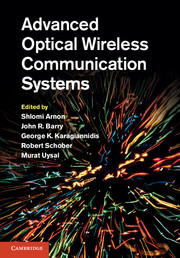Book contents
- Frontmatter
- Contents
- List of contributors
- Part I Outlook
- Part II Optical wireless communication theory
- Part III Unique channels
- 8 Modeling and characterization of ultraviolet scattering communication channels
- 9 Free-space optical communications underwater
- 10 The optical wireless channel
- 11 Hybrid RF/FSO communications
- Part IV Applications
- Index
11 - Hybrid RF/FSO communications
from Part III - Unique channels
Published online by Cambridge University Press: 05 June 2012
- Frontmatter
- Contents
- List of contributors
- Part I Outlook
- Part II Optical wireless communication theory
- Part III Unique channels
- 8 Modeling and characterization of ultraviolet scattering communication channels
- 9 Free-space optical communications underwater
- 10 The optical wireless channel
- 11 Hybrid RF/FSO communications
- Part IV Applications
- Index
Summary
Introduction
In free-space optical (FSO) communication an optical carrier is employed to convey information wirelessly. FSO systems have the potential to provide fiber-like data rates with the advantages of quick deployment times, high security, and no frequency regulations. Unfortunately such links are highly susceptible to atmospheric effects. Scintillation induced by atmospheric turbulence causes random fluctuations in the received irradiance of the optical laser beam [1]. Numerous studies have shown that performance degradation caused by scintillation can be significantly reduced through the use of multiple-lasers and multiple-apertures, creating the well-known multiple-input multiple-output (MIMO) channel (see e.g. [2], [3], [4], [5], [6], [7], [8], [9], [10]). However, it is the large attenuating effects of cloud and fog that pose the most formidable challenge. Extreme low-visibility fog can cause signal attenuation on the order of hundreds of decibels per kilometer [11]. One method to improve the reliability in these circumstances is to introduce a radio frequency (RF) link to create a hybrid FSO/RF communication system [12], [13], [14], [15], [16], [11]. When the FSO link is blocked by cloud or fog, the RF link maintains reliable communications, albeit at a reduced data rate. Typically a millimeter wavelength carrier is selected for the RF link to achieve data rates comparable to that of the FSO link. At these wavelengths, the RF link is also subject to atmospheric effects, including rain and scintillation [17], [18], [19], [20], [21], but less affected by fog.
- Type
- Chapter
- Information
- Advanced Optical Wireless Communication Systems , pp. 273 - 302Publisher: Cambridge University PressPrint publication year: 2012
- 2
- Cited by



